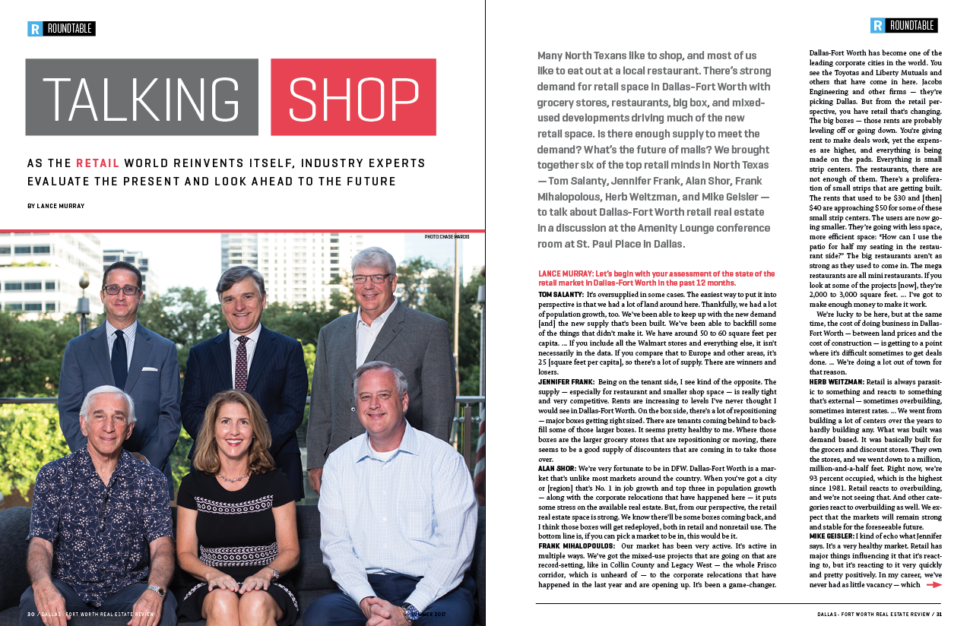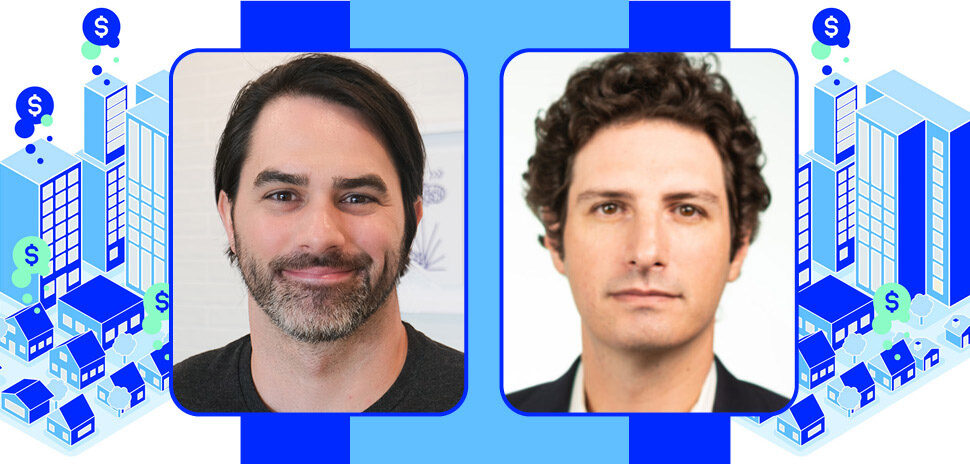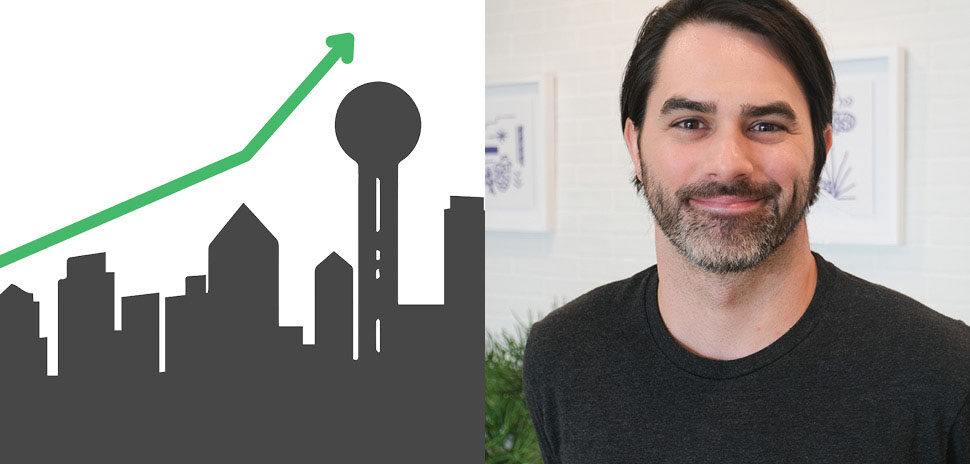![]() How we eat out — and how we shop — is changing. In a recent roundtable discussion, six Dallas-area retail real estate experts examine the nationwide food hall movement, the future of malls, and where North Texas is seeing activity. Tom Salanty, Jennifer Frank, Alan Shor, Frank Mihalopolous, Herb Weitzman, and Mike Geisler shared their expert thoughts on Dallas-Fort Worth retail real estate in a discussion at the Amenity Lounge conference room at St. Paul Place in Dallas.
How we eat out — and how we shop — is changing. In a recent roundtable discussion, six Dallas-area retail real estate experts examine the nationwide food hall movement, the future of malls, and where North Texas is seeing activity. Tom Salanty, Jennifer Frank, Alan Shor, Frank Mihalopolous, Herb Weitzman, and Mike Geisler shared their expert thoughts on Dallas-Fort Worth retail real estate in a discussion at the Amenity Lounge conference room at St. Paul Place in Dallas.
P A R T O N E: Malls & Halls This is part one in a series of extended content from the roundtable, “Talking Shop,” that originally appeared in the Summer 2017 edition of the Dallas-Fort Worth Real Estate Review. The discussion was edited for length and clarity.

The Panel
Jennifer Frank, Principal, Segovia Retail Group
Mike Geisler, Founding Principal, Managing Partner, Venture Commercial Real Estate
Frank Mihalopoulos, Owner, Corinth Properties
Tom Salanty, Managing Director, JLL Dallas
Alan Shor, Co-Founder, President, Co-Chairman, Retail Connection LP
Herb Weitzman, Founder, Executive Chairman, Weitzman Group
Moderator
Lance Murray , Managing Editor, Dallas-Fort Worth Real Estate Review and Dallas Innovates
Where are you seeing retail activity in Dallas-Fort Worth? Are you seeing more substantial new builds or more repurposing of properties?
ALAN SHOR: We’re going to see more repurposing. You have construction costs continuing to rise at an unsustainable rate. You’ve got fewer retailers growing. And those that are growing are putting more pressure on rent. You’ve got dark boxes coming back, you’ve got e-commerce. We’ve been a pretty active ground-up developer. I’m telling our guys that development is going to get quiet for a while — let’s find things we can buy and repurpose. With the dark space that will come back — particularly department stores that will get divided up and re-tenanted — we’re seeing that’s going to be the trend for a while.
FRANK MIHALOPOULOS: There are only a handful — less than a handful — of big projects going on with the big boxes. They’re in Grand Prairie and north Fort Worth, but there aren’t many mega centers being built. What is being built is mixed-use, so the retail that’s being built is ancillary to another job center or something else that’s coming in and generating the traffic. What is being built is the small strip centers. It reminds me somewhat of the 1980s because unanchored strip centers were probably what most of the FDIC RTC properties were. There were a lot of folks building centers that hadn’t done them before. [Like the ’80s], some are running with small tenants.
The mall business is contracting very, very fast. Even in Dallas, we’ve lost half the malls — either they’re closed, or they’re in foreclosure. The good operating malls … we were at 26, and now we’re down to 13.
Herb Weitzman
Just as you get involved in the business, and you’re a broker/tenant rep — next thing you know, you’re building ten little strip centers for your tenants, and you’re speculating. It will be interesting to see in the next 12 months how much of that gets done — or what’s left and where it is. … If we start compromising principles, you will have some issues. Fast-casual restaurant growth has created a big demand for some of this space. And, a center today is not just your shopping center with a big parking lot — there’s a hotel in it, there’s going to be an office building, there’s a retail center mixed in the ground floor of a hospital.
HERB WEITZMAN: I’ll speak to new centers. Plano is on fire because of the corporate relocations and the population growth. Those projects [are] unique, [and among] the very few in the United States that big being built. The mall business is contracting very, very fast. Even in Dallas, we’ve lost half the malls — either they’re closed, or they’re in foreclosure. The good operating malls … we were at 26, and now we’re down to 13. In the non-mall projects, primarily community centers and power centers, we’re actively leasing. Twenty five are under construction around the state now, and probably another eight where there are very active anchor leases being made for new centers. That part of the business is just excellent; however, you’ve got to be at the right location. And the numbers have to prove out. That sector of the business is the best place to be in today. I don’t know if you need to lose any sleep over that type of retail being in harm’s way of e-commerce. It competes very well.
JENNIFER FRANK: There’s a lot of repurposing of malls. For example, the Midtown project, which is the former Valley View Mall, is being repurposed into a mixed-use development. It’s owned by three separate entities, and they’re planning a high densification for office, some retail, and a wellness component. Ridgmar Mall in Fort Worth is bringing in a big aquarium and an indoor go-cart track. It’s [for] entertainment and the “active lifestyle” that they’re repurposing some of these malls. The Starwood Mall in Plano at Willowbend has taken the former Lord and Taylor space and turned it into about six restaurants. They’re working on a theater deal, as well as a hotel. … We will see a lot more of that as these boxes continue to shut down.
What do you think about the future of malls?
SALANTY: Absolutely, there’s a future for malls.
WEITZMAN: Malls are classified “A,” “B,” and “C.” Class A malls are doing probably $550, $600 a square foot or better. They’re doing very well. … “C” malls are $300 to $450, and “B” malls are around $450 to $550. Most of these malls have to be upgraded, and it takes a lot of capital. There’s been a polarization of ownership with the public REITs, and they own most of the good malls.
Tom (Salanty) sells a lot of malls in the “B” and “C” category, and they’re like a drug on the market today. In other words, if you’re growing your sales and you put money into it, and you have a good location, you’ve got a good opportunity of doing well — increasing sales, getting tenants, and growing it. But if you’ve got a crowded area with malls that overlap each other in sales, e-commerce is hurting the chain businesses that are in malls. You see it from the top down. Department stores are getting hit, and they’re having a tough time competing on sales. Their sales are dropping across the board. There are a few winners, like Nordstrom.
Even as well as J.C. Penney is operating with the level of leadership they have, they’re struggling. I think they’re going to make it. Fortunately, [former Chief Executive Officer] Ron Johnson went ahead and improved a lot of the stores … They’re new, and they’re clean, and there’s new leadership changing the merchandising mix. It’s helping their sales. I think they’ll do well, but it’s a struggle for those who are moving too slow.
But, e-commerce is converging with brick and mortar. It’s happening. … Amazon has this tremendous cost of shipping, and you see Wal-Mart coming with 63 percent in e-commerce sales last quarter … They’ve figured it out, and they can distribute out of their 4,700 stores. That’s convenient to the customer. What I read is, [Wal-Mart] has a store within 10 miles of everyone in the United States. They don’t have the shipping costs. … There’s a convergence, and it’s still working itself through the market. There are going to be winners and losers.
Mall operators in the “B” and “C” markets are repurposing malls in a nonretail way: You’ve got government annex offices going into the malls. You’ve got junior colleges and community colleges going in the malls.
Alan Shor
SHOR: If you believe the press, the experts say that 25 percent of malls are going to be out of business in five years — some 250, 260 malls. That’s a tremendous amount of square footage. The mall operators — and you can count them on one hand — the Simons and the GGPs, they’re saying, “Wait a minute, we’re not just going to stand by and watch this happen.” These guys have started investing in retail companies to put into their malls.
Simon, particularly, has gotten aggressive with what they believe to be growth retailers. They will put money in them, just like a private equity firm. Other mall operators in the “B” and “C” markets are repurposing malls in a nonretail way: You’ve got government annex offices going into the malls. You’ve got junior colleges and community colleges going in the malls. It’s interesting how the owners on the mall side are reacting to this.
They’re not just sitting back and saying, “Let it happen.” They know the department stores are in trouble, but they’re very proactive, and we’re going to see more and more of this in the nonretail and the entertainment spaces where they’re going to be the anchors in the malls.
MIKE GEISLER: What you will see in weaker communities are call centers, data centers, and government offices. And in [other] communities, most of these malls are in great real estate. I can see Collin Creek being redeveloped and being much more dense and diverse. And I think that’s one thing you can probably see — any of the malls that are at risk in DFW are at pretty outstanding intersections.
WEITZMAN: I think the malls are going to fail. I think the numbers are correct. We monitor rents on a monthly basis for about 3,000 tenants, and I see the sales in strips. I was in meetings yesterday, and every center had increased sales, but malls — the “B” malls and “C” malls couldn’t say that. Their sales are dropping. It’s just that the country is over-retailed. When you go lay Amazon on top of an overbuilt mall community, so many people are buying more and more on Amazon and online. I see a lot of failures. I’m not saying they’re not going to be repurposed, but I don’t think they’re going to be retailed.
GEISLER: I agree.
MIHALOPOULOS: You have to look at the mall as a whole picture, “A,” “B,” “C,” and “D” malls. We’ve been playing that field for 10 years — living with the REITs and living with the department stores. We see the “A” malls will stay “A” malls. Those are going to be general growth — your Macerich, your Simons — they’re going to run those high-end malls, and keep them going. They’ll always be there.
Then there are the “B” malls that are evolving to try to be “A” malls. There’s Tommy Morel who sold The Starwood [Group]. There’s a group of people who have tried to fix those malls, [like] Rouse Company, and the second layer of ownership — Starwood and WP Glimcher. Now it’s going to be Prime again. They’re trying to create the malls and keep them going. Throw in a Dick’s, throw in an H&M, and try to get them to a “B-plus” or an “A-minus” mall.
Then you’ve got a category of the “B” to “C” malls that are operating. In some cases, they might be the only place in town with nothing around for 200 miles. Those will survive. Pueblo, Colorado — or somewhere in the middle of nowhere — [those malls are] the place for 300 miles. In cases where there’s a big mall down the street — or even 50 miles away or another city — those are going to suffer. There’s a layer of financing from foreign money buying the “C” malls just to cash flow them. They’re being dumped on the market by the REITs, so they’re buying them at a 12 percent.
MIHALOPOULOS: They’re not even paying utility bills sometimes. They’re just trying to grab as much as they can — get their money out as quickly as they can — and then there will be a skeleton left. You have something like 10 malls that sold last year in this category. And you hear horror stories where tenants are trying to stay open. So those are going to die.
The next level we look at is location. It can be a dying mall, but a great piece of real estate. We ask, “Can you repurpose it?”
Frank Mihalopoulos
The next level we look at is location. It can be a dying mall, but a great piece of real estate. We ask, ‘Can you repurpose it?’ We’ve been able to take these and put in medical clinics. We did one of the big ones with Pinnacle Medical Clinic … 450,000 square feet of retail and 450,000 square feet of offices and medical clinics. It’s the model of mixed-use in Nashville.
The second mall we did [was] in York, Pennsylvania — a small town. There was a purpose for it to be a town center. We opened it up, turned it inside out, and put in traditional tenants and the DSWs of the world, Ulta, and Burlington. …
Another case, one we’re doing in Atlanta, is in a neighborhood that can’t compete with the perimeter malls or [other nearby centers]. We see it as a mixed-use. We have a Macy’s, a Penney’s, and we’re working with Sears to — hopefully — put them out of their misery. In that case, maybe we can get a grocery store to take over that wing.
We’re [also] working on 300,000 square feet of offices. We can deliver offices $10 to $15 [per square foot] below market rate because we open up the mall and mix-use it. [It’s] the whole idea of having a better workplace — with higher ceilings — so it’s a fun place to work.Now it becomes a place to entertain and react. What we’re trying to do is create a different place.
WEITZMAN: Have you ever made money on those? Interest rates are picking up, and everybody is getting squeezed from home builders on up. How does it look for the future in the conversion, because it’s awfully expensive?
MIHALOPOULOS: We have to buy it right. We’re not buying the specialty income. There are a lot of temporary tenants and specialty tenants in these malls. That’s where it’s kind of like a drug that keeps going. You can’t pay for that. We’re buying it for land and building values, and that’s how you can get it fixed. We have participation from public money, we’re tearing down a building, and we open up a park. You’re going to get some incentives. It’s a case-by-case basis.
When a department store meets with a mall owner, it’s a summit; it’s not a meeting.
Frank Mihalopoulos
Every property has its own story. The problem is, there are too many malls. There was a dysfunctionality of the big mall developers and the department stores. It started back in the ’70s and ’80s. If you remember: I’m going to build this wonderful mall — but [in the case of a] department store, you’re going to have to take three of my malls, because I am building these other secondary malls around the country. If you want to be here, you are going to do these deals. When a department store meets with a mall owner, it’s a summit; it’s not a meeting. It’s how they’re going to manipulate all their portfolio. That created a lot of the things that shouldn’t even be here today.
SHOR: That’s also an opportunity that goes beyond the malls. We just bought a center in Longview, Texas. It’s a center that’s adjacent to the mall there — the only mall there. It’s got temporary tenants in it. It’s probably 80 percent leased. We bought it right, to Frank’s point. We got it at the right basis. It’s almost like a cash-flowing covered land play. We will cash-flow it — cash flow is very healthy — until it’s time to rebuild it. We’re holding. We’re going to hold cash flow. We have a three- to four-year plan to redevelop and rebuild it. In the meantime, the risk is mitigated by the cash flow and the cost basis. Those are going to be the opportunities going forward.
SALANTY: I do this around the country. There are 1,300 malls. I think there are 300 to 400 that closed. But I think that what you need to understand is what happened. The department stores’ net worth in ’07 was $85 billion. Today, it’s $26 billion. The off-price retailers’ value in ’07 was $18 billion. Today, it’s $75 billion. That’s market cap.
You might add a million square feet to a market, and you didn’t add any new people. That’s not true in Dallas. … We’re growing, so we keep up. We’re unique in the United States.
Tom Salanty
The shift is, in the ’70s and ’80s we built all these malls in population centers. Then [it was] the power centers in the ’90s — most of them late ’90s, early ’00s. You might add a million square feet to a market, and you didn’t add any new people. That’s not true in Dallas. … We’re growing, so we keep up. We’re unique in the United States. I tell people when I go into a meeting: I live in Dallas, Texas. I live in the best city, in the best state, in the best country in the world. That’s what I tell people, because we have a lot of good things happening here.
Today, we are going through another shift. Retailers change the way they merchandise and the way they distribute — that’s what is going to happen. This has happened several times. If you want to look in Dallas at examples that you can understand, the old Prestonwood Mall was a Neiman Marcus-anchored center. They didn’t go to the Galleria because it was too close — it was within five miles of NorthPark mall. They go up to Prestonwood, and it goes from a Neiman Marcus center to a data center that then failed in the telecom boom. Today, it’s a Wal-Mart. Back to the discounters with the growing value. One of the first malls I ever sold was Six Flags Mall over 15 years ago. Finally, it’s selling, or making a deal with the City of Arlington now, and GM is picking it up to do supplier work. The same thing is happening in Detroit with the mall Ford is taking over.
Most of you may have attended RECon (The Global Retail Real Estate Convention) last May. What were your major takeaways?
GEISLER: I think the summit at ICSC was very positive, more than I expected. I think that everybody was there to do business. But there was less business being done. It’s a healthy industry, but it’s an industry that’s adapting and reacting to tremendous change, more change than it’s ever experienced in my lifetime.
WEITZMAN: The interesting thing is, the non-mall business is probably 96 percent of all the centers in the country. Most of the business is still done in non-mall projects. And there’s a whole group of tenants that thrive with visibility and easy in, easy access that serve the neighborhoods. Those are the community centers which are really the backbone of retailing in this country.
MIHALOPOULOS: The other part I sensed was capital — the banks being very cautious, traditional banks on construction loans — it’s very hard to get loans right now unless you put enough equity in. But the equity players that were there — the capital structure — it feels like there were more people bringing capital to the markets because they think there’s an opportunity. Because of the change in what’s going on, there’s also a change in how the structure looks at it. Half our meetings were with capital people.
What Amazon is building is what [Sears] already had. All they had to learn was … get on the internet. [Sears] had the infrastructure, and they would’ve been a package.
Frank Maholopoulos
I saw an interesting presentation by Marcus & Millichap. They showed us Sears versus Amazon: Where Sears was, what Sears had, and what Amazon is trying to build. Sears — the stores, catalog, distribution centers, and warehouses — the whole network was there. It was the number-one company at one time in America. And then Amazon started with an idea of selling books online. What they built was exactly what Sears had — a distribution facility, the catalog store. Now, [Amazon] is starting to get into brick and mortar to some extent. It was because Sears didn’t understand — they didn’t get the play of the internet and what was changing in the world — that they became a real estate play that was bought. They merged with Kmart. They’re falling apart on this side, and Amazon is building up … What Amazon is building is what [Sears] already had. All they had to learn was … get on the internet. [Sears] had the infrastructure, and they would’ve been a package.
Evolution happens to these retailers. How many of us did Blockbuster deals? It was a leading tenant in the ’80s and ’90s, and then something called Netflix showed up and changed the whole world. It’s part of what we see — there’s change every day here. One thing is, the majority of all sales — still 85, 90 percent — are still done brick and mortar, not on the internet. If you ask somebody in this room the total of internet sales in trillions of dollars of sales, [they would say] it’s 13 percent. Some call it 15 percent.
There’s education that needs to go on in the stores. There are a lot of products out there, and people don’t know what’s right for them.
Tom Salanty
SALANTY: The last set of numbers that were published by ICSC was 10 percent, and it was based on 2015 numbers. It’s certainly getting bigger. We don’t know where the number is today. It’s interesting to note that mail order — the pure-play online retailers — was 3.7 percent of the 10 percent at that time. Mail order catalog [is] still 3.1 percent. That business has been around for a long time. Omni-channel retailers are 2 percent. There’s another percent, the non-merchandise stuff, which is shipping. That’s what makes up the 10 percent. And all that is growing a little bit. We’re watching this change, but the brick and mortar is the last mile. There’s also education that needs to go on in the stores. There are a lot of products out there, and people don’t know what’s right for them, so they go into IKEA and pick something. They go into Best Buy and pick something.
The top five internet retailers are Amazon, Apple, Dell, Walmart, and Staples. How many of those have stores, of those five? A majority.
MIHALOPOULOS: But Amazon is over 50 percent of the internet sales.
SALANTY: Getting bigger — and getting brick-and-mortar stores.
SHOR: You look at what Wal-Mart is doing in the dot com. Wal-Mart made the decision, “we can’t do it organically like Amazon — we’re going to do it by acquisitions.” They buy jet.com for a billion dollars, which gives them the infrastructure. They buy Bonobos, Mod Market, and one or two other specialty retailers and e-commerce retailers. They’re going to do it by acquisition. I think they’re going to be a very formidable competitor to Amazon. And Walmart.com is going be a very strong player.
SALANTY: They’re not going to give up, I will tell you that.
The food hall movement is a growing trend. Do you think anybody has really figured out how to get it right?
FRANK: “Food hall” is a big buzz word. Alongside food and theater, alongside all the new [retail experience] concepts— whether it’s an iFly indoor skydiving [center] or a multitude of different indoor concepts — it’s [about] bringing experience to the retail segment so the consumer will want to go to this destination to do their shopping, versus across town where there aren’t all the experiential-type components to it.
MIHALOPOULOS: I call it a food court on steroids sometimes. [In New York City], if you go to the food hall at the World Trade Center by Brookfield, it’s in a sophisticated office building, and it looks great. But, there’s not a lot of people. Yet, [other projects] are packed. And a lot of that traffic is driven by tourists.
[In Dallas-Fort Worth], the food hall at Legacy West could work. If there are 45,000 people working there, it’s going to create the traffic. It’s traffic generation that’s going to keep it going.
“Food hall” is a big buzz word. … it’s [about] bringing experience to the retail segment so the consumer will want to go to this destination to do their shopping, versus across town.
Jennifer Frank
FRANK: When you go to these places, they have a wide range of choices. If they keep it current and relevant to the demographic that they’re in, it should do well.
MIHALOPOULOS: Trinity Groves [in Dallas] is a food hall, basically. It’s an incubator of 2,500-square-foot restaurants that work because they’re small. It goes back to they don’t want the big restaurant, they want a “get me started.” It gives you that something unique. If [the food halls are] done at the right place with the smaller restaurants, that’s what brings individuality — that creates an environment, and it works.
TOM SALANTY: [Trinity Groves has] the downtown lunch crowd that keeps them busy, — a couple turns during lunch, and then they’ll do a couple turns at dinner. If you make four turns in a restaurant, you’re going to make it. You make two turns in a restaurant, you might not.
Next up in the Talking Shop series
Part Two: Technology and Retail
Part Three: Want to Test a Concept? Come to Dallas-Fort Worth
About the panel
Jennifer Franks is principal at Segovia Retail Group, and has more than 20 years of experience in commercial real estate leasing and development. Her specialty is tenant representation throughout Texas, Arkansas, Louisiana, and Oklahoma. Her clients include IKEA, Ulta Cosmetics, Bath and Body Works, and rue21.
Mike Geisler is founding principal and managing partner at Venture Commercial Real Estate, which he co-founded in 2000 with longtime business colleague and friend, Kenneth Reimer. Geisler has spent more than 30 years as a real estate broker and 20 years leasing specialty and lifestyle centers.
Frank Mihalopoulos is the owner of Corinth Properties and has more than 37 years of experience in real estate investments and development of commercial retail and office properties. He has developments throughout the country, and is a graduate of Southern Methodist University.
Tom Salanty is managing director at JLL in Dallas, having joined the firm in 2016. He has more than three decades of experience in the commercial real estate sector, particularly in the sales of shopping centers.
Alan Shor is a co-founder of The Retail Connection LP, and serves as its president and co-chairman of the board. He is involved in TRC’s strategic direction, and he oversees the day-to-day operations of the company. Shor leads TRC’s investment and merchant banking business.
Herb Weitzman is executive chairman of the Weitzman Group, which he founded in 1990. It is a full-service real estate brokerage firm with the largest retail real estate brokerage force in Texas and one of the largest regional commercial estate firms in the nation. It ranks among the top 50 shopping center management firms in the country.
‘Talking Shop’ was published in the Fall 2017 edition of the Dallas-Fort Worth Real Estate Review. The retail roundtable discussion was transcribed and has been edited for length and clarity. The online version includes extended content.
READ NEXT
Getting in the Game: Arlington Repurposing Convention Center into Esports Stadium
The Esports Arlington Stadium is set to become the largest esports arena in the country.
Could Arlington’s Smart District Water Meters Save Money, Avert Disaster?
Redevelopment Breathes New Life Into Real Estate That’s Run its Course
Repurposing retail real estate in Arlington
 “Talking Shop” Roundtable
“Talking Shop” Roundtable
Retail Real Estate in Dallas-Fort Worth
How we eat out — and how we shop — is changing. In a recent roundtable discussion, six Dallas-area retail real estate experts examine the nationwide food hall movement, the future of malls, and how North Texas is a center of activity.
Part One: Halls and Malls
As the retail world reinvents itself, real estate industry experts evaluate the present and look ahead to the future.
Part Two: Technology and Retail
Perspectives on how technology, big data, and the internet continues to change the way we shop.
Part Three: Want to Test a Concept? Come to Dallas-Fort Worth
The retail landscape is changing as service providers, grocers, health care delivery systems, and experiential concepts take on traditional retail space.
![]()
Get on the list.
Sign up to keep your eye on what’s new and next in Dallas-Fort Worth, every day.
One quick signup, and you’re done.
View previous emails.
Read ‘Talking Shop’ in the Real Estate Review digital edition on Issuu.
The Dallas-Fort Worth Real Estate Review is published quarterly. Sign up for the digital alert here.

































